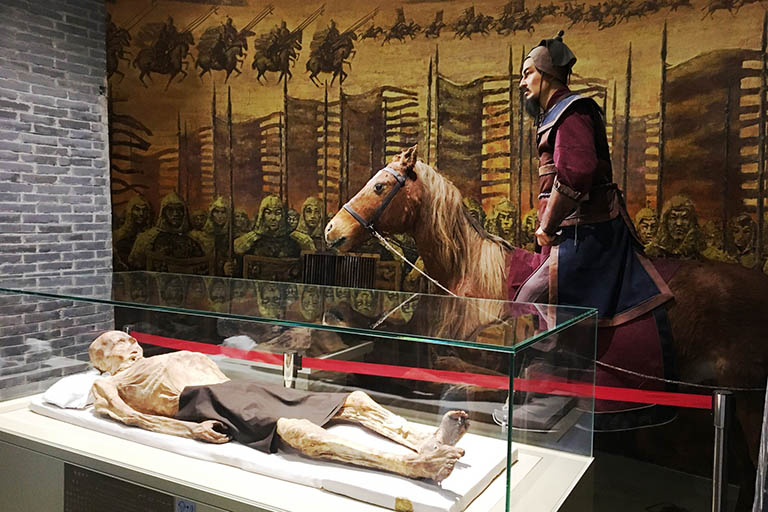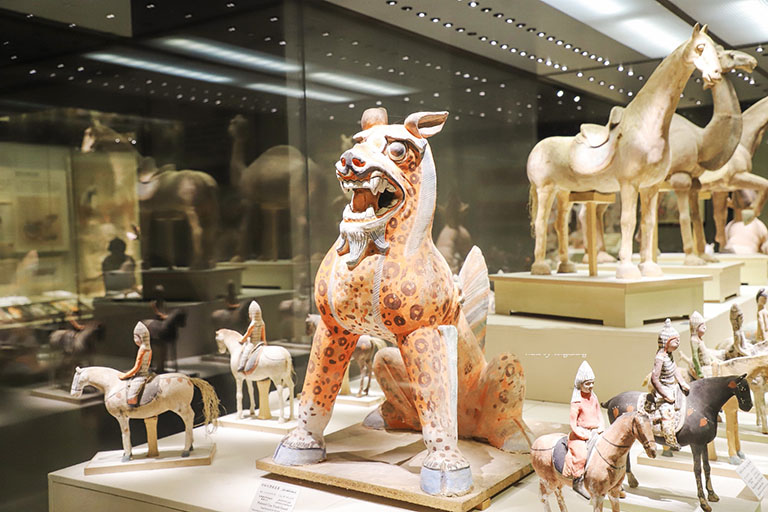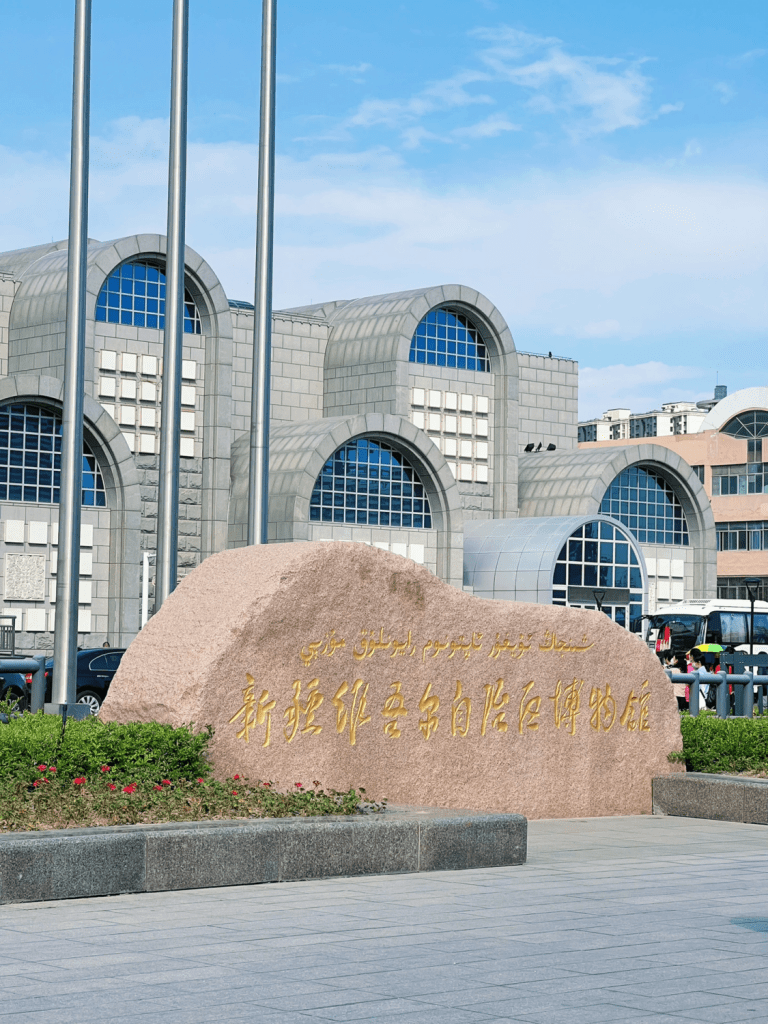Your Ultimate Guide to the Xinjiang Museum: Discovering Ancient Treasures

An Essential Guide to Visiting Xinjiang Museum
Nestled in the vibrant heart of Urumqi, the Xinjiang Museum (新疆博物馆) stands as a magnificent testament to the rich tapestry of history and culture that characterizes this unique region of China. With its fascinating collection spanning thousands of years, the museum serves as a vital window into the diverse heritage of the Xinjiang Uygur Autonomous Region. From ancient artifacts to modern exhibitions, visitors will find themselves immersed in the stories of the Silk Road, the traditions of the ethnic minorities, and the evolution of the land itself.
As the top-rated attraction in Urumqi, the museum boasts an impressive array of themed halls—each dedicated to different aspects of Xinjiang’s past, including bronze relics, ancient mummies, and exquisite textiles from various dynasties. The attention to detail in the exhibits will captivate your imagination, providing a deeper understanding of the cultural interactions that have shaped this crossroads of civilizations.
Planning a visit? Expect to spend at least a few hours exploring the treasures on display. While the museum is primarily designed with Chinese-speaking audiences in mind, the wealth of visual information and the layout of the exhibits will guide you through this historical journey, even if you don’t speak the language. Whether you’re a history buff, an art enthusiast, or simply curious about the world, the Xinjiang Museum promises an enlightening experience that will leave a lasting impression on your travels. Prepare to be amazed as you uncover the narratives of a region steeped in mystery and allure.
In This Guide
- An Essential Guide to Visiting Xinjiang Museum
- The Rich History and Legends of Xinjiang Museum
- Main Highlights: What You Absolutely Can’t Miss
- Planning Your Visit: A Practical Guide
- Tickets: Prices, Booking, and Tips
- How to Get There: A Complete Transportation Guide
- Local Cuisine and Accommodation Nearby
- Frequently Asked Questions
- Final Thoughts on Your Trip
The Rich History and Legends of Xinjiang Museum
Nestled in the heart of Urumqi, the Xinjiang Museum (新疆博物馆) is not just a repository of artifacts; it is a vibrant tapestry of the region’s rich history and captivating legends. Established to showcase the diverse cultural heritage of Xinjiang, this museum takes visitors on a journey through centuries, encapsulating the narratives of various dynasties and the myriad ethnic groups that have called this land home.
The museum’s inception dates back to 1953, born from a desire to preserve and promote the unique history of Xinjiang, a region that has long been a crossroads of cultures. Over the decades, it has evolved into the largest museum in the autonomous region, with an impressive collection that includes over 100,000 artifacts. Each piece tells a story, reflecting the traditions, lifestyles, and beliefs of the peoples who have inhabited this area, from the ancient Silk Road traders to the nomadic tribes of the steppes.
Among its most renowned exhibits are the remarkably preserved mummies from the Tarim Basin, which date back thousands of years and provide intriguing insights into the lives of early inhabitants. These mummies, alongside an astonishing array of bronze artifacts and textiles, highlight the artistic and technological advancements achieved by various cultures throughout history.
As you stroll through the museum’s numerous halls—each dedicated to a different theme—you’ll encounter not only historical artifacts but also the legends that have shaped the region. Xinjiang’s history is steeped in tales of adventure and resilience, from the legendary Silk Road journeys that connected the East and West to the folklore of the Uygur people, who have preserved their rich oral traditions through generations.
The museum’s layout is thoughtfully designed to engage visitors of all ages, offering detailed explanations and interactive displays that bring history to life. However, it is worth noting that most informational texts are in Chinese, which may pose a challenge for international visitors. Despite this, the visual splendor of the exhibits captivates, providing an enriching experience that transcends language barriers.
With its well-curated collections and engaging presentations, the Xinjiang Museum stands as a testament to the region’s storied past and vibrant cultural tapestry. It invites all who enter to explore the legacies of those who walked before us, making it an essential first stop for anyone seeking to understand the heart and soul of Xinjiang. Whether you’re a history buff, a culture enthusiast, or simply curious about this unique part of the world, the museum promises an enlightening experience that resonates long after your visit.

Xinjiang Museum.
Main Highlights: What You Absolutely Can’t Miss
When visiting the Xinjiang Museum in Urumqi, you’re stepping into a treasure trove of history and culture that showcases the rich tapestry of this diverse region. Here are the must-see highlights that you absolutely can’t miss:
1. Pre-Qin Hall
Make your way to the second floor and immerse yourself in the Pre-Qin Hall, where detailed exhibitions narrate the fascinating historical developments of Xinjiang. The carefully curated displays will take you on a journey through the region’s ancient societies and cultural branches. The exhibition is noted for its compelling narrative and educational approach, making it an engaging experience for all.
2. Bronze Artifacts
One of the standout features of the museum is its extensive collection of bronze artifacts. These items, crafted during various dynasties, offer a glimpse into the artistry and technological advancements of ancient Xinjiang. Be sure to spend time exploring these intricately designed pieces, as they reflect the rich cultural heritage of the region.
3. Mummies of Xinjiang
Prepare to be captivated by the museum’s display of well-preserved mummies, which are among the oldest in the world. These fascinating artifacts provide insight into the burial practices and lifestyles of ancient peoples who once inhabited the area. The mummies are not just historical remnants; they tell stories of a bygone era that continue to intrigue researchers and visitors alike.
4. Dynastic Clothing Exhibit
The clothing exhibit showcases garments from different dynasties, illustrating the evolution of fashion and textiles across centuries. From elaborate ceremonial attire to everyday wear, this collection highlights the artistic and practical aspects of clothing design in Xinjiang, making it a visual delight for fashion enthusiasts and history buffs.
5. Top Treasures of the Museum
Don’t miss the chance to seek out the museum’s top ten treasures. While you may not have time to view all of them in one visit, each treasure holds its own unique story and significance. Be sure to check the museum’s guide for details on where to find these highlights.
6. Educational Displays
The museum is renowned for its informative text labels and educational devices that enhance the visitor experience. While most explanations are in Chinese, the museum’s layout and visual storytelling make it accessible for international travelers. Take your time to absorb the information; you could easily spend three hours here without needing an external guide.
7. Vibrant Atmosphere
The museum is a popular destination, attracting visitors from all walks of life. Expect a lively atmosphere as you navigate through the halls, where you can observe local families, students, and tourists sharing in the discovery of Xinjiang’s heritage.
Planning Your Visit
The Xinjiang Museum is open from 10:30 AM to 4:30 PM, Tuesday to Sunday (closed on Mondays). Given its extensive collection, consider arriving early in the day to maximize your experience. It’s an ideal first stop on your journey through Xinjiang, setting the stage for the rich cultural encounters that await you throughout the region.
In summary, the Xinjiang Museum is not just a place to view artifacts; it’s an invitation to explore the profound history and cultures that have shaped this unique part of China. Whether you’re an avid history lover or simply curious about the world, this museum promises an enlightening and memorable experience.

Xinjiang Museum.
Planning Your Visit: A Practical Guide
When planning your visit to the Xinjiang Museum (新疆博物馆) in Urumqi, you’re embarking on a journey through the rich tapestry of this unique region’s history and culture. Here’s everything you need to know to make the most of your experience.
Getting There
The Xinjiang Museum is conveniently located at No. 132 Xibei Road, Urumqi. It’s easily accessible by taxi or local public transport. If you’re staying in the city center, a short taxi ride will get you there in no time.
Opening Hours
The museum welcomes visitors from Thursday to Tuesday, with operating hours from 10:30 AM to 4:30 PM. It’s closed on Wednesdays, so be sure to plan your visit accordingly. Given the extensive exhibitions, arriving early is advisable to fully explore the museum before closing.
Ticketing Information
Entrance fees are generally affordable, often offering discounts for students and seniors. It’s a good idea to check for any special exhibitions that may require separate tickets. To avoid long lines, consider purchasing your tickets online in advance if available.
Exhibition Highlights
The Xinjiang Museum boasts a wide range of exhibits across 6 to 8 halls, each dedicated to unique themes—ranging from ancient bronze artifacts and mummies to clothing from various dynasties. The detailed exhibition texts provide a thorough understanding of the artifacts, though note that English translations can be limited. Visitors often recommend spending at least three hours to fully appreciate the museum’s offerings.
Recommended Duration
While many travelers find two hours insufficient to see everything, allocating three to four hours allows for a more leisurely pace, giving you ample time to absorb the rich narratives and details behind each exhibit.
Guided Tours
For a deeper understanding of the exhibits, consider joining a guided tour. While the museum is navigable independently, a knowledgeable guide can enrich your visit with insights and historical context, making your experience even more rewarding.
Nearby Attractions
After your museum visit, consider exploring nearby attractions. The Red Hill and People’s Park of Urumqi are both within a short distance and offer beautiful landscapes for a relaxing stroll. You can also find an array of dining options nearby, featuring local cuisine that’s perfect for refueling after a day of exploration.
Dining Options
There are several restaurants within walking distance, offering a range of dining experiences. Local hotpot places such as Nei MengGu Yang JiGu Hotpot and Huo Yan Shan Hot Pot are highly recommended for those looking to sample authentic Xinjiang flavors.
Tips for Your Visit
- Plan for Crowds: The museum can get busy, especially on weekends and holidays. Visiting on a weekday may provide a more tranquil experience.
- Dress Comfortably: Wear comfortable shoes as you will be walking and standing for extended periods.
- Stay Hydrated: Bring a water bottle to keep hydrated during your visit, especially during the warmer months.
- Photography: Check the museum’s photography policy if you plan to take photos, as some areas may have restrictions.
By following this guide, you’ll be well-prepared for an enriching visit to the Xinjiang Museum, where the past comes alive through its fascinating artifacts and exhibits. Enjoy your journey through one of China’s most culturally diverse regions!

Xinjiang Museum.
Tickets: Prices, Booking, and Tips
When planning your visit to the Xinjiang Museum (新疆博物馆), it’s essential to know about ticket prices, how to book, and some helpful tips to enhance your experience.
Ticket Prices
Visiting the Xinjiang Museum is quite budget-friendly. As of now, general admission is free, which makes it an excellent option for travelers looking to explore without breaking the bank. However, keep in mind that special exhibitions may have separate fees, so it’s wise to check in advance or inquire at the entrance.
Booking Tickets
Currently, there is no need for advance booking for general admission as it operates on a first-come, first-served basis. However, during peak tourist seasons or weekends, it can get quite crowded, so arriving early is advisable. For special exhibitions, if applicable, keep an eye on the museum’s official website or local tourism platforms for any updates regarding reservation requirements.
Visiting Hours
The museum is open Thursday to Tuesday from 10:30 AM to 4:30 PM, and it remains closed on Wednesdays. Plan your visit accordingly to make the most of your time there.
Tips for Your Visit
-
Allocate Enough Time: With multiple halls showcasing a variety of themes—from bronze artifacts to ancient mummies—visitors typically find that two hours isn’t enough. Aim for at least three hours to fully immerse yourself in the exhibits.
-
Language Considerations: While the museum offers detailed exhibitions, English translations are limited. If you’re not familiar with Chinese, consider downloading a translation app or bringing along a guidebook for better understanding.
-
Beat the Crowds: To avoid long lines and crowded exhibits, try to visit during weekdays or early in the morning. This will allow you to navigate the halls at a more leisurely pace.
-
Guided Tours: For a deeper understanding of the exhibits, look into guided tours, which may be available through local travel agencies. These can provide valuable context and enhance your experience significantly.
-
Combine with Nearby Attractions: The Xinjiang Museum is conveniently located near several other attractions in Urumqi. Plan your itinerary to include a visit to nearby landmarks such as Red Hill or People’s Park, making for a fulfilling day of exploration.
By keeping these details in mind, your visit to the Xinjiang Museum will be both enjoyable and enriching, offering a fascinating glimpse into the region’s rich history and culture.
How to Get There: A Complete Transportation Guide
Visiting the Xinjiang Museum (新疆博物馆) is a fantastic way to immerse yourself in the rich history and culture of the Xinjiang region. To make your trip as smooth as possible, here’s a comprehensive transportation guide to help you get there with ease.
Getting to the Xinjiang Museum
Location:
The Xinjiang Museum is conveniently situated at No.132 Xibei Road, Urumqi 830000, China, making it easily accessible from various points in the city.
Arriving by Air
Urumqi Diwopu International Airport (URC):
Most international travelers arrive at Urumqi Diwopu International Airport. Once you land, here are your options:
- Taxi: The airport is located approximately 20 kilometers from the city center. Taxis are readily available outside the terminal. The ride to the museum will take around 30-40 minutes depending on traffic and should cost between 60-100 RMB.
- Airport Shuttle Bus: The airport offers shuttle buses that connect to various points in Urumqi. You can take a shuttle to the city center and then transfer to a local bus or taxi to reach the museum.
Arriving by Train
Urumqi Railway Station serves as a significant hub for train travelers. If you’re coming from other major cities in China, you can take a high-speed train to Urumqi.
- Taxi: Upon arrival at the station, taxis are available outside. The museum is about 10-15 minutes away by taxi, costing around 20-30 RMB.
- Public Bus: Alternatively, local buses operate from the station. Check the current routes and schedules, as they may vary. The bus ride will take a bit longer but is an economical option.
Local Transportation
Once you’re in Urumqi, there are several convenient ways to reach the museum:
- Public Buses: Urumqi has an extensive bus network. Look for routes that stop near the Xinjiang Museum. The fare is quite affordable, usually around 1-2 RMB.
- Taxis: Taxis are plentiful throughout the city, and you can easily hail one or use a ride-hailing app. Expect to pay around 15-30 RMB for a short trip within the city.
- Walking: If you’re staying nearby, consider walking to the museum. The area around the museum is pedestrian-friendly and provides a chance to explore the local culture along the way.
Tips for Your Visit
- Timing: The museum opens at 10:30 AM and closes at 4:30 PM, with Mondays being the only closure day. Plan your transportation accordingly to make the most of your visit.
- Language Barrier: While many taxis will understand basic English, it’s helpful to have your destination written in Chinese. You can use a translation app or print out your destination beforehand.
With this transportation guide, you’re all set to explore the captivating exhibits of the Xinjiang Museum. Enjoy your journey through history and culture!

Xinjiang Museum.
Local Cuisine and Accommodation Nearby
When visiting the Xinjiang Museum, you’ll find yourself immersed in a vibrant cultural tapestry that extends beyond the exhibits. The surrounding area offers a variety of culinary delights and comfortable accommodations, perfect for enhancing your experience in Urumqi.
Savoring Local Flavors
The diverse cuisine of Xinjiang is a tantalizing blend of Chinese and Central Asian influences, renowned for its bold flavors and unique dishes. Here are some local eateries that you shouldn’t miss:
-
Nei MengGu Yang JiGu Hotpot (0.3 mi away)
This popular spot serves a delightful hotpot experience, allowing you to cook fresh ingredients to your liking. It’s a great way to enjoy a communal meal while sampling various meats and vegetables. -
Huo Yan Shan Hot Pot (0.4 mi away)
Another fantastic hotpot restaurant, known for its spicy broths and a wide selection of ingredients. Perfect for those who love a bit of heat in their meals! -
HongGuan JiaoMaJi (0.3 mi away)
A great option for traditional Xinjiang dishes, including lamb skewers and hand-pulled noodles. The casual atmosphere makes it a favorite among locals. -
ABu LaDe Nang (0.7 mi away)
This eatery specializes in naan (a staple bread in Xinjiang) and is a fantastic place to try local breads paired with rich, savory stews.
Resting in Comfort
After a day of exploring the museum and indulging in the local cuisine, you’ll want a comfortable place to rest. Here are a few accommodations nearby:
-
Urumqi International Hotel
Just a short distance from the museum, this hotel offers modern amenities and a welcoming atmosphere. Guests can enjoy spacious rooms and on-site dining options that include local dishes. -
Grand Mercure Urumqi Hualing
This hotel features comfortable rooms and is known for its excellent service. Located conveniently for both sightseeing and dining, it’s an ideal base for your Xinjiang adventure. -
Sheraton Urumqi Hotel
A bit further out, but worth the stay for its luxurious accommodations and top-notch amenities. The Sheraton offers a blend of Western and local cuisine in its restaurants, making it a great choice for international travelers.
Conclusion
With its rich history and vibrant culinary scene, Urumqi offers a perfect backdrop for your visit to the Xinjiang Museum. Whether savoring traditional dishes or relaxing in comfortable accommodations, you’ll find plenty of options to make your stay enjoyable and memorable.

Xinjiang Museum.
Frequently Asked Questions
-
What are the operating hours of the Xinjiang Museum?
The Xinjiang Museum is open from 10:30 AM to 4:30 PM, Thursday through Tuesday. It is closed on Wednesdays, so make sure to plan your visit accordingly. -
How much time should I allocate for my visit?
It’s recommended to spend at least three hours exploring the museum to fully appreciate the diverse exhibits, including bronze artifacts, mummies, and cultural artifacts from various dynasties. Many visitors have noted that two hours may not be sufficient to see everything. -
Is there an admission fee?
Admission to the Xinjiang Museum is generally free, but it’s always a good idea to check their official website or local guides for any updates or special exhibitions that may require tickets. -
Are there English descriptions available for the exhibits?
While many exhibits contain detailed information in Chinese, English descriptions are somewhat limited. If you’re not familiar with Chinese, consider joining a guided tour to enhance your understanding of the displays. -
What are the top exhibits to see in the museum?
The museum features several must-see exhibits, including the Pre-Qin Hall, which showcases significant historical narratives, bronze artifacts, and mummies. Look out for the top 10 treasures of the museum; however, be prepared to spend extra time searching for them! -
Can I take photos inside the museum?
Photography policies can vary, so it’s advisable to check for any signage regarding photography when you enter. Some areas may allow photos while others may not, especially around sensitive exhibits. -
Are there facilities available for visitors?
The museum is equipped with basic visitor facilities, including restrooms and possibly a café or snack bar. However, be prepared for crowds, especially during peak visiting hours, which may affect your experience. -
What else can I do nearby after visiting the museum?
After your museum visit, consider exploring nearby attractions such as the People’s Park of Urumqi, Red Hill, or the bustling Grand Bazaar for a taste of local culture and cuisine. There are also several restaurants within walking distance if you’re looking to grab a meal.
Final Thoughts on Your Trip
As you wrap up your visit to the Xinjiang Museum, take a moment to reflect on the rich tapestry of history and culture you’ve encountered. This museum is more than just a collection of artifacts; it is a vibrant portal into the diverse narratives that have shaped this region. From the intricate bronze artifacts to the haunting mummies and the beautifully preserved clothing of various dynasties, each exhibit tells a story waiting to be discovered.
Many travelers have noted that a few hours may not suffice to fully immerse yourself in all that the museum has to offer. With six to eight themed halls, each filled with treasures, your curiosity will undoubtedly lead you down fascinating paths of exploration. While the textual explanations primarily cater to a Chinese-speaking audience, the visuals and the sheer grandeur of the exhibits speak a universal language that transcends barriers.
Whether you’re a history enthusiast or simply a curious wanderer, the Xinjiang Museum provides an invaluable glimpse into the past, making it a must-visit stop on your journey through this extraordinary region. As you leave, carry with you the stories of the Uyghur culture, the echoes of ancient civilizations, and the understanding that Xinjiang is a crossroads of heritage where every artifact is a testament to the resilience and ingenuity of its people.
Take the time to cherish these memories, and let them inspire your future travels. Xinjiang awaits your return, with many more stories to tell. Safe travels!